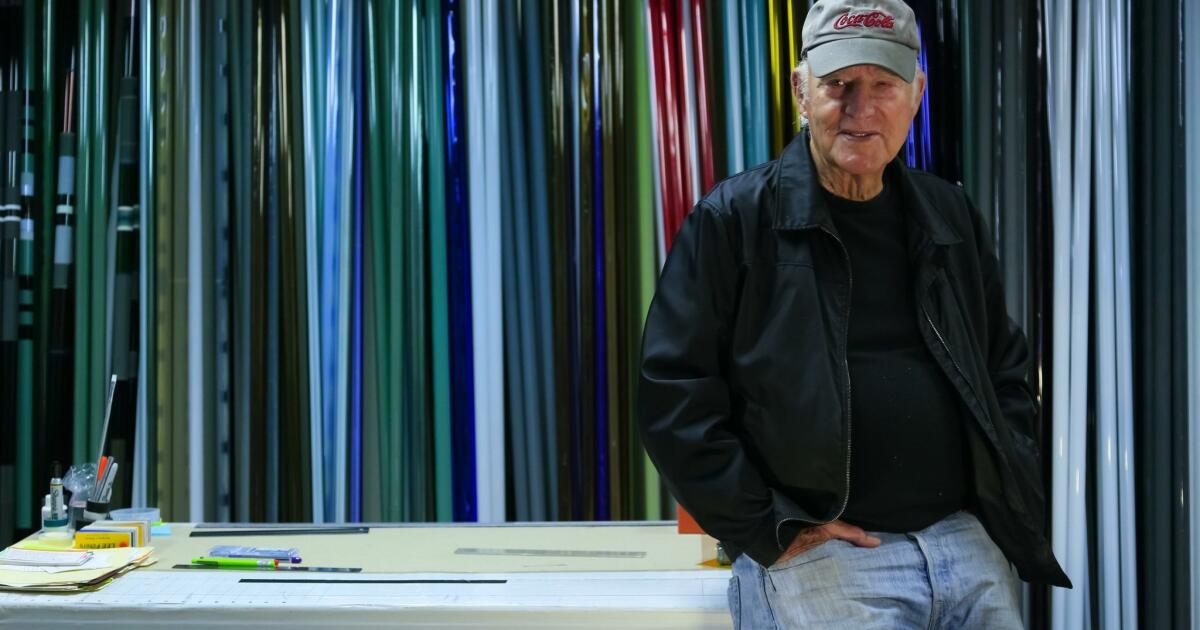
Robert Irwin, a longtime San Diego artist associated with the Light and Space movement of the 1960s who early on stopped making paintings in favor of creating ephemeral and sometimes intangible art environments, died Wednesday at Scripps Memorial Hospital in La Jolla.
He was 95.
Within the contemporary art world, Irwin’s work on human attention and perception — he called it, with a nod to scientific research, an “inquiry” into perception — was highly influential. He won a MacArthur “genius” award in 1984.
Kathryn Kanjo, director and CEO of the Museum of Contemporary Art San Diego, said in a statement Wednesday that his impact on the art world was immense.
“Robert Irwin’s passing will be felt across the art world and is especially poignant in our community and at the Museum of Contemporary Art San Diego,” which holds the largest museum collection of Irwin’s work. He first had a solo exhibition at MCASD in 1969 and a career retrospective in 2007.
“His work is foundational to a certain West Coast minimalism, referred to as Light and Space. Deeply engaged with the limits and nuances of perception, he complicated the boundaries between art and its environment, coining the term ‘site-conditional,’” she said in the statement.
“Indeed, in September 2021, just prior to the museum’s reopening, Bob oversaw the placement of ‘Spanish Fan’ (1995), a radiant glass sculpture in our outdoor sculpture garden. A gift of the artist, the piece is a permanent reminder of his talent and generosity.
“It joins one of the artist’s most beloved and recognizable site-conditional installations, ‘1° 2° 3° 4°.’ In a subtle but transformative gesture, the artist cuts into the gallery’s windows opening the interior space to the exterior beyond. Light, air, sea, and sound blend in visual, spatial and sensorial wonder. This installation reflects so many of the unexpected ways in which Irwin makes us ever more aware of the world around us,” Kanjo said.

Robert Irwin, “Getty Central Garden,” 1997, mixed media (construction and plant materials)
(J. Paul Getty Museum)
Until the late 1970s, Irwin did not allow his projects to be photographed. He long gravitated toward site-specific works that were temporary in nature, such as the time he drew a square on the ground with string for the 1976 Venice Biennale. And even with his more permanent works — such as his design of the Getty Center garden in Los Angeles for its 1997 opening, or his work as the master planner behind the Dia Beacon museum in upstate New York for its opening in 2003 — it can be hard to identify his handiwork.
But that kind of parsing may be beside the point. Irwin identified his goal — and the underlying goal of modern art generally — as awakening viewers’ powers of observation and concentration so that they become active participants in the experience.
“Irwin’s work is not about a particular medium — so he can do a garden, a scrim piece, a piece of string on the ground,” said writer Lawrence Weschler, who made Irwin’s sometimes abstruse philosophic approach to making art accessible in his book “Seeing Is Forgetting the Name of the Thing One Sees” (1982).
“Having said that,” Weschler continued, “there’s a laser beam consistency to his essential project throughout his career: trying to get people to perceive how they perceive.”
Or, as Irwin told Hugh Davies, who was then the director of MCASD, in a 2007 interview: “The pure subject of art is human perception. Once you take that position, it changes all the rules of the game for what you do and how you do it.”

Artist Robert Irwin had three rectangles cut in the tinted windows of the Museum of Contemporary Art San Diego’s oceanview gallery, framing details of the beautiful vista.
(Courtesy of MCASD)
Boredom and serenity
Robert Walter Irwin was born Sept. 12, 1928, in Long Beach, to Overton and Goldie (Anderberg) Irwin. His father ran a contracting business in Los Angeles that thrived in the 1920s but failed during the Depression, when Robert Irwin was growing up. His father later worked for the local department of water and power.
Irwin grew up in the Baldwin Hills area. By the time he graduated from Dorsey High School, some early interests, such as drawing, hot rods and betting on the horses at the Hollywood Park racetrack, were clear. (When art sales weren’t paying the bills, wagers at the track helped.)
After joining the Army and spending time stationed in Europe, Irwin returned to L.A. and attended a string of art schools. But he found himself bored by the coursework. More central to his development, he said, was another experience in the mid-1950s: eight months he spent alone in a cabin on Ibiza — then little more than a desolate island off the coast of Spain — without talking to anyone.
It was during this period of thinking, and emptying his mind of thoughts, that Irwin discovered both excruciating boredom and total serenity. And it was this kind of intensity that, once he was back in L.A., earned this relatively untested artist a spot in 1958 at the fabled Ferus Gallery, which helped launch local artists such as Ed Ruscha and Billy Al Bengston, as well as New York superstar Andy Warhol.
Irwin’s style in the late 1950s consisted of large, second-generation abstract expressionist paintings that were inspired, he admitted, by Bengston. That would soon change: Irwin’s development in the 1960s, which he often described as a Zen-like emptying out of the painting plane, culminated in his abandonment of picture making altogether.
The first step, he often said, was his line paintings, an attempt to reduce “incidental distractions” by making an increasingly limited number of gestures across a canvas. Then came the so-called dot paintings, which had even less of an identifiable subject, as painted dots were dispersed across the canvas like something gaseous in nature.
Then he started making curved discs: three-dimensional paintings made of aluminum or acrylic that seem to float ethereally against the wall.
In 1969, the Los Angeles County Museum of Art invited Irwin to contribute to its Art and Technology program, which paired artists and scientists. Irwin asked Dr. Edward Wortz of the Garrett Aerospace Corp. and James Turrell, a fellow Light and Space artist, to be his collaborators. They conducted sensory deprivation experiments at UCLA and took copious notes.
But before any artwork was realized, Turrell withdrew from the project, and he and Irwin famously stopped speaking to each other for decades. They also made great efforts in interviews to distinguish one man’s work from the other’s.

Robert Irwin stretched translucent scrim panels inside rooms to disperse light at the Pace Gallery.
(David Hollander / Courtesy of Pace Gallery)
“The difference between me and Turrell leaving a room empty is that Turrell would make you take your shoes off — it becomes a ritual for him,” Irwin said in a 2007 interview.
Turrell said in an unpublished interview a few years later, “I think that’s fair,” referring to his travels to Japan, where “it wasn’t a big thing to take off your shoes there.”
“Also, if you have a ranch,” he continued, “taking your dirty bits off in the anteroom or mud room, you can really keep the house cleaner. It has helpful connotations, other than just the visual.”
The two artists eventually did resume speaking.
“What happened was my fault,” Turrell said. “There were jealousies on my part, being the younger artist. He had been showing longer and had his gallery and exhibitions already. I felt that my ideas were as good ideas as his, but I did not have the same ease of showing.”
Indeed, museum shows — even those focusing on near-empty rooms — came early to Irwin, and he never returned to painting.
In 1970, he reworked a rather homely leftover space at the Museum of Modern Art in New York through a few minimal gestures, including revamping the lighting fixtures and hanging a scrim from the ceiling.
In 1975, at the Museum of Contemporary Art in Chicago, he transformed an empty room by running wide black tape across the floor to complete a rectangle formed by the black border at the bottom of the room’s other walls. In 1980, he replaced the facade of a gallery in Venice, California, with a white scrim, in effect exhibiting the gallery rather than anything inside it.
In 2020, when he was 91, Irwin staged an exhibition under the title “Unlights” at Pace Gallery in New York City, a show he called his “swan song.” It featured eight new sculptural works, composed of 6-foot fluorescent lights, installed on a wall in vertical rows and wrapped in layers of theatrical gels. “The results are ravishingly gorgeous, and compoundingly confounding,” Weschler wrote in The New York Times.
Irwin also tried his hand at high-profile public projects, designing airports, parks and city monuments. Most went unrealized for budget or planning reasons, but he did complete a few large-scale works.
After 15 years and multiple iterations, he transformed the site of an abandoned Army hospital on the outskirts of Marfa, Texas, owned by the Chinati Foundation, into a walk-in installation defined by rows of windows and series of scrims. It opened in 2016. A 2023 documentary film, “Robert Irwin: A Desert of Pure Feeling,” using time-lapse video of the construction, presents the project as the culmination of his experimentation with light.
He is survived by his wife, Adele (Feinstein) Irwin; their daughter, Anna Grace Irwin; and a sister, Patricia.
Finkel writes for the New York Times. Union-Tribune Arts and Entertainment Editor Pam Kragen contributed to this report.

Artist Robert Irwin at the MCASD exhibition “Robert Irwin: Primaries and Secondaries,” the largest exhibition of Irwin’s work since 1993. The exhibition featured five new major installation works created specifically for the Museum of Contemporary Art San Diego’s downtown galleries and was drawn almost exclusively from the museum’s collection.
(Courtesy of MCASD)






